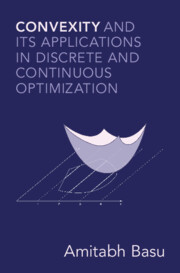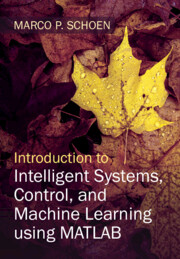Refine search
Actions for selected content:
1550 results in Control systems and optimization
4 - Network Optimization
-
- Book:
- Hands-On Mathematical Optimization with Python
- Published online:
- 14 May 2025
- Print publication:
- 16 January 2025, pp 91-129
-
- Chapter
- Export citation
6 - Conic Optimization
-
- Book:
- Hands-On Mathematical Optimization with Python
- Published online:
- 14 May 2025
- Print publication:
- 16 January 2025, pp 174-202
-
- Chapter
- Export citation
3 - Mixed-Integer Linear Optimization
-
- Book:
- Hands-On Mathematical Optimization with Python
- Published online:
- 14 May 2025
- Print publication:
- 16 January 2025, pp 48-90
-
- Chapter
- Export citation
Contents
-
- Book:
- Hands-On Mathematical Optimization with Python
- Published online:
- 14 May 2025
- Print publication:
- 16 January 2025, pp vii-ix
-
- Chapter
- Export citation
Appendix B - Solutions of Selected Exercises
-
- Book:
- Hands-On Mathematical Optimization with Python
- Published online:
- 14 May 2025
- Print publication:
- 16 January 2025, pp 311-330
-
- Chapter
- Export citation
Acknowledgments
-
- Book:
- Hands-On Mathematical Optimization with Python
- Published online:
- 14 May 2025
- Print publication:
- 16 January 2025, pp xix-xx
-
- Chapter
- Export citation
Dedication
-
- Book:
- Hands-On Mathematical Optimization with Python
- Published online:
- 14 May 2025
- Print publication:
- 16 January 2025, pp v-vi
-
- Chapter
- Export citation
2 - Linear Optimization
-
- Book:
- Hands-On Mathematical Optimization with Python
- Published online:
- 14 May 2025
- Print publication:
- 16 January 2025, pp 15-47
-
- Chapter
- Export citation
8 - Robust Optimization
-
- Book:
- Hands-On Mathematical Optimization with Python
- Published online:
- 14 May 2025
- Print publication:
- 16 January 2025, pp 213-238
-
- Chapter
- Export citation
5 - Convex Optimization
-
- Book:
- Hands-On Mathematical Optimization with Python
- Published online:
- 14 May 2025
- Print publication:
- 16 January 2025, pp 130-173
-
- Chapter
- Export citation
Index
-
- Book:
- Hands-On Mathematical Optimization with Python
- Published online:
- 14 May 2025
- Print publication:
- 16 January 2025, pp 333-334
-
- Chapter
- Export citation

Convexity and its Applications in Discrete and Continuous Optimization
-
- Published online:
- 14 January 2025
- Print publication:
- 30 January 2025

Introduction to Intelligent Systems, Control, and Machine Learning using MATLAB
-
- Published online:
- 27 November 2023
- Print publication:
- 16 November 2023
-
- Textbook
- Export citation
Appendix D - Selected MATLAB Code
-
- Book:
- Introduction to Intelligent Systems, Control, and Machine Learning using MATLAB
- Published online:
- 27 November 2023
- Print publication:
- 16 November 2023, pp 436-458
-
- Chapter
- Export citation
Appendix C - Introduction to Simulink
-
- Book:
- Introduction to Intelligent Systems, Control, and Machine Learning using MATLAB
- Published online:
- 27 November 2023
- Print publication:
- 16 November 2023, pp 423-435
-
- Chapter
- Export citation
Preface
-
- Book:
- Introduction to Intelligent Systems, Control, and Machine Learning using MATLAB
- Published online:
- 27 November 2023
- Print publication:
- 16 November 2023, pp xiii-xviii
-
- Chapter
- Export citation
5 - Optimization: Soft Computing
-
- Book:
- Introduction to Intelligent Systems, Control, and Machine Learning using MATLAB
- Published online:
- 27 November 2023
- Print publication:
- 16 November 2023, pp 142-176
-
- Chapter
- Export citation
Index
-
- Book:
- Introduction to Intelligent Systems, Control, and Machine Learning using MATLAB
- Published online:
- 27 November 2023
- Print publication:
- 16 November 2023, pp 470-472
-
- Chapter
- Export citation
Appendix G - Project Descriptions and Parts List
-
- Book:
- Introduction to Intelligent Systems, Control, and Machine Learning using MATLAB
- Published online:
- 27 November 2023
- Print publication:
- 16 November 2023, pp 467-469
-
- Chapter
- Export citation
Contents
-
- Book:
- Introduction to Intelligent Systems, Control, and Machine Learning using MATLAB
- Published online:
- 27 November 2023
- Print publication:
- 16 November 2023, pp vii-xii
-
- Chapter
- Export citation
